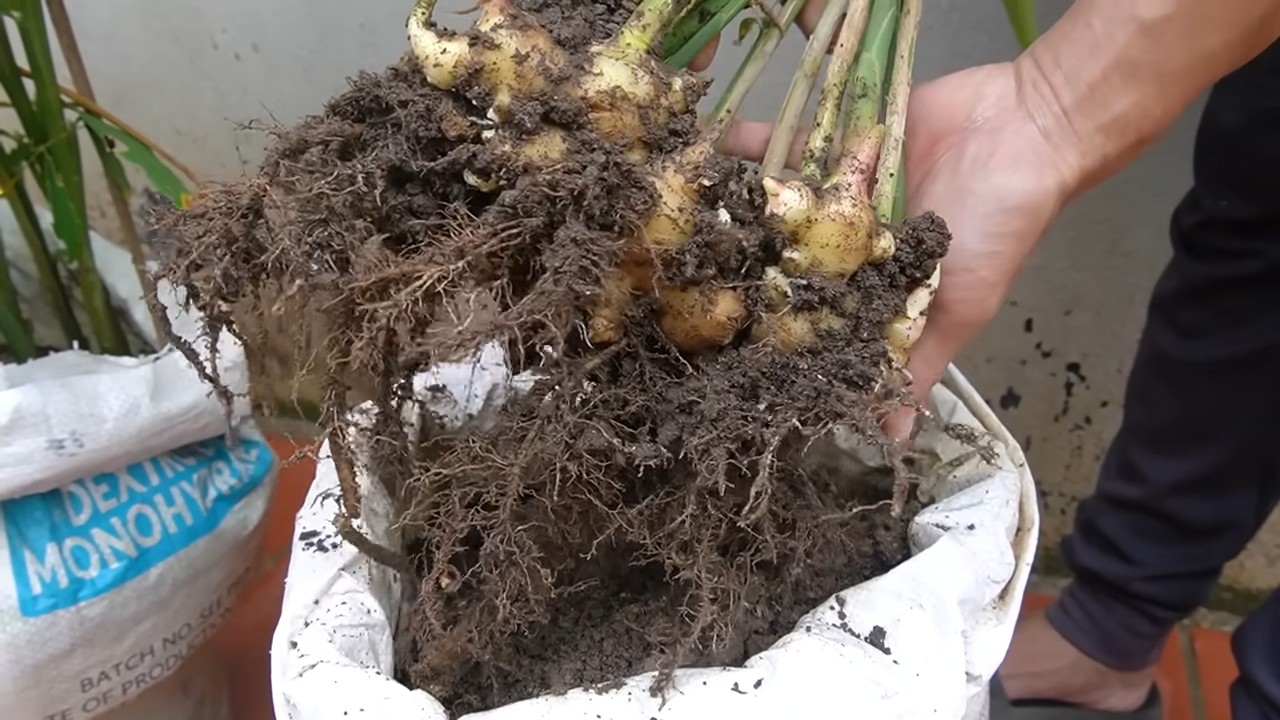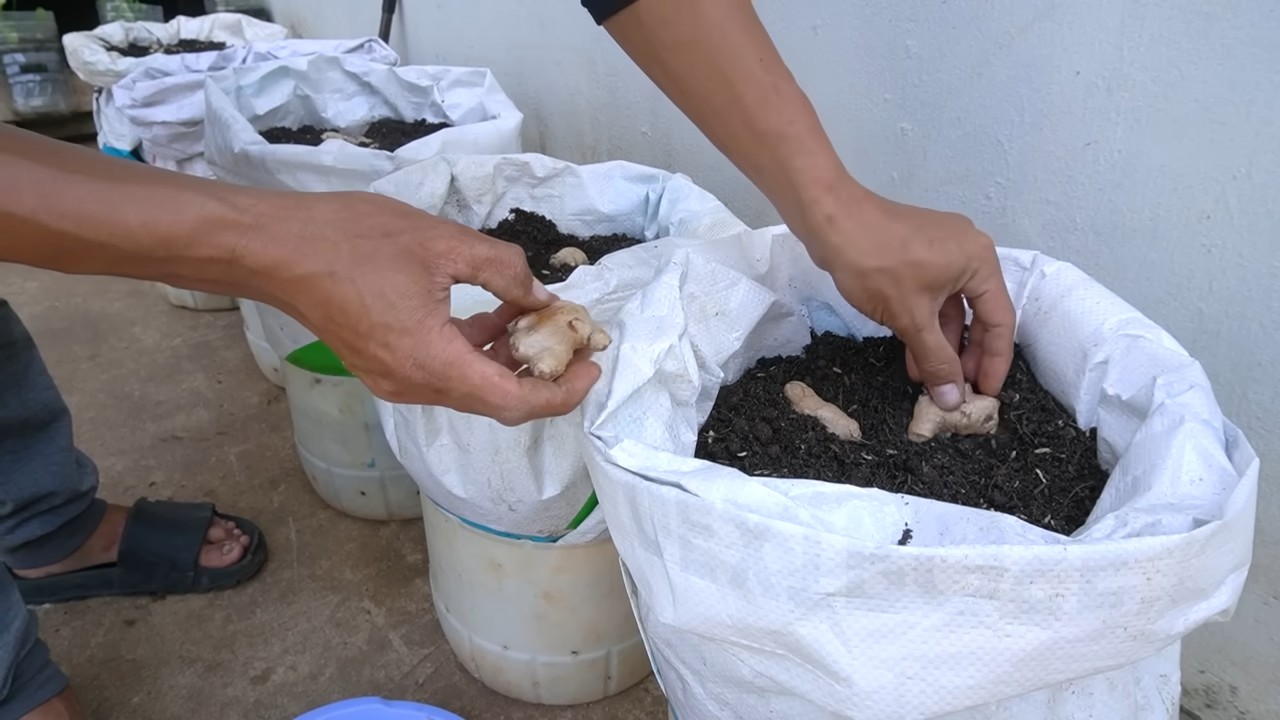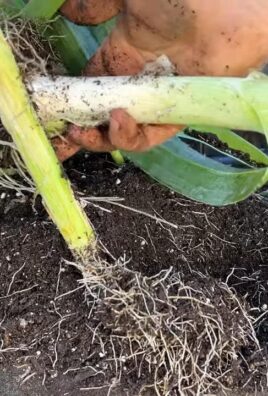Grow Ginger at Home – imagine the satisfaction of snipping off a piece of fresh, zesty ginger root right from your own backyard (or even your windowsill!). Forget those bland, store-bought rhizomes; we’re diving headfirst into the wonderful world of homegrown ginger, and I’m so excited to share my best tips and tricks with you!
Ginger, with its fiery flavor and incredible health benefits, has been cultivated for thousands of years. Originating in South Asia, it quickly spread across the globe, becoming a staple in cuisines and traditional medicine systems from India to China and beyond. For centuries, ginger has been more than just a spice; it’s been a symbol of prosperity, a remedy for ailments, and a key ingredient in countless cultural rituals.
But why should you bother learning to grow ginger at home? Well, for starters, the taste is simply unmatched. Freshly harvested ginger is more vibrant and aromatic than anything you’ll find on supermarket shelves. Plus, think of the money you’ll save! No more exorbitant prices for a tiny piece of ginger. More importantly, you’ll have complete control over the growing process, ensuring your ginger is free from harmful pesticides and chemicals. I’m going to show you how to easily cultivate this amazing plant, even if you have limited space or gardening experience. Get ready to unleash your inner gardener and enjoy the delicious rewards!

Grow Your Own Ginger: A Beginner’s Guide
Hey there, fellow plant enthusiasts! Ever thought about growing your own ginger? It’s surprisingly easy and incredibly rewarding. Imagine fresh, homegrown ginger ready whenever you need it for cooking, teas, or even just a little zing in your life. I’m going to walk you through the whole process, step-by-step, so you can enjoy the satisfaction of harvesting your own spicy rhizomes.
What You’ll Need
Before we dive in, let’s gather our supplies. Here’s a checklist of everything you’ll need to successfully grow ginger at home:
* Ginger Rhizome: Look for a plump, healthy-looking ginger root at your local grocery store or nursery. It should have visible “eyes” or buds (small bumps) on it. Organic ginger is often recommended, as it’s less likely to have been treated with growth inhibitors.
* Potting Mix: Use a well-draining potting mix. A mix designed for vegetables or herbs works great. Avoid heavy clay soils, as they can lead to root rot.
* Pot: Choose a pot that’s at least 12 inches in diameter and 12 inches deep. Ginger roots grow horizontally, so a wider pot is better than a taller one. Make sure it has drainage holes!
* Watering Can or Hose: For watering your ginger plant.
* Spray Bottle (Optional): For misting the plant to increase humidity.
* Warm Location: Ginger thrives in warm temperatures (ideally between 65°F and 90°F).
* Indirect Sunlight: Ginger needs bright, indirect sunlight. Avoid direct sunlight, which can scorch the leaves.
* Fertilizer (Optional): A balanced liquid fertilizer can help boost growth.
Preparing the Ginger Rhizome
This is a crucial step to get your ginger off to a good start. We want to encourage those little buds to sprout!
1. Soaking the Rhizome (Optional): Some people like to soak the ginger rhizome in water overnight before planting. This can help rehydrate it and encourage sprouting. I’ve had success both with and without soaking, so it’s really up to you. If you choose to soak, just place the ginger in a bowl of water and let it sit for 12-24 hours.
2. Cutting the Rhizome (If Necessary): If your ginger rhizome is large, you can cut it into smaller pieces, making sure each piece has at least one or two “eyes” or buds. This will allow you to grow multiple ginger plants from a single rhizome. Use a clean knife or pruners to make the cuts. Let the cut pieces air dry for a day or two to allow the cut surfaces to callous over. This helps prevent rot.
Planting the Ginger
Now for the fun part – getting that ginger in the soil!
1. Fill the Pot: Fill your pot with potting mix, leaving about an inch or two of space at the top.
2. Plant the Rhizome: Place the ginger rhizome on top of the soil, with the “eyes” or buds facing upwards.
3. Cover with Soil: Gently cover the rhizome with about 1-2 inches of potting mix.
4. Water Thoroughly: Water the soil thoroughly until water drains out of the drainage holes. This helps settle the soil and provides the ginger with the moisture it needs to start growing.
Caring for Your Ginger Plant
Consistent care is key to a healthy and productive ginger plant.
1. Watering: Keep the soil consistently moist, but not waterlogged. Water when the top inch of soil feels dry to the touch. Overwatering can lead to root rot, so be careful not to overdo it. I usually check the soil moisture every other day.
2. Sunlight: Place your ginger plant in a location that receives bright, indirect sunlight. An east-facing window is often ideal. If you’re growing it outdoors, make sure it’s in a spot that’s shaded during the hottest part of the day.
3. Temperature: Ginger thrives in warm temperatures. Aim for a temperature range of 65°F to 90°F. If you live in a colder climate, you may need to bring your ginger plant indoors during the winter months.
4. Humidity: Ginger loves humidity. If you live in a dry climate, you can increase humidity by misting the plant regularly with a spray bottle or placing a tray of water near the plant. Grouping plants together can also help increase humidity.
5. Fertilizing (Optional): You can fertilize your ginger plant every few weeks with a balanced liquid fertilizer. Follow the instructions on the fertilizer label. I usually dilute the fertilizer to half strength to avoid burning the roots.
Harvesting Your Ginger
Patience is a virtue, especially when it comes to growing ginger. But the wait is worth it!
1. When to Harvest: You can start harvesting ginger about 8-10 months after planting. The leaves will start to turn yellow and die back when the ginger is ready to harvest.
2. Harvesting Process: To harvest, gently dig around the plant and lift the rhizomes out of the soil. You can harvest the entire plant or just a portion of the rhizomes, leaving the rest to continue growing.
3. Storing Your Ginger: Freshly harvested ginger can be stored in the refrigerator for several weeks. You can also freeze it for longer storage. To freeze, peel and chop the ginger into small pieces, then place them in a freezer bag or container.
Troubleshooting
Even with the best care, you might encounter a few challenges along the way. Here are some common problems and how to address them:
* Yellowing Leaves: Yellowing leaves can be caused by overwatering, underwatering, or nutrient deficiencies. Check the soil moisture and adjust your watering accordingly. If you suspect a nutrient deficiency, try fertilizing with a balanced liquid fertilizer.
* Root Rot: Root rot is caused by overwatering and poor drainage. Make sure your pot has drainage holes and avoid overwatering. If you suspect root rot, you may need to repot the plant in fresh potting mix.
* Pests: Ginger plants can be susceptible to pests such as aphids and spider mites. Inspect your plant regularly for pests and treat them with insecticidal soap or neem oil if necessary.
Tips for Success
Here are a few extra tips to help you grow the best ginger possible:
* Choose the Right Variety: There are different varieties of ginger, each with its own unique flavor and characteristics. Experiment with different varieties to find one that you enjoy.
* Use High-Quality Potting Mix: The quality of your potting mix can have a big impact on the health of your ginger plant. Use a well-draining potting mix that’s rich in organic matter.
* Provide Adequate Drainage: Good drainage is essential for preventing root rot. Make sure your pot has drainage holes and avoid overwatering.
* Be Patient: Ginger takes time to grow. Don’t get discouraged if you don’t see results right away. With proper care, you’ll be harvesting your own ginger in no time!
* Experiment: Don’t be afraid to experiment with different growing techniques to find what works best for you. Gardening is all about learning and having fun!
Growing your own ginger is a rewarding experience that anyone can enjoy. With a little bit of patience and care, you can have a steady supply of fresh ginger right at your fingertips. Happy gardening!

Conclusion
So, there you have it! Growing ginger at home is not only achievable, but it’s also a deeply rewarding experience that connects you to the origins of your food. Forget those bland, store-bought rhizomes that have been sitting on shelves for weeks. Imagine the vibrant, aromatic ginger you can harvest straight from your own garden or even a sunny windowsill. The difference in flavor is truly remarkable, offering a zest and intensity that will elevate your culinary creations to a whole new level.
This DIY trick is a must-try for several compelling reasons. First and foremost, it’s incredibly cost-effective. A single piece of ginger from the grocery store can become the seed for a thriving plant, yielding a continuous supply of fresh ginger for months to come. Secondly, it’s an environmentally conscious choice. By growing your own ginger, you’re reducing your reliance on commercially produced ginger, which often involves long-distance transportation and potentially harmful agricultural practices. Finally, it’s simply a fun and educational project that can be enjoyed by gardeners of all skill levels.
But the beauty of growing ginger at home lies in its adaptability. Feel free to experiment with different varieties of ginger, such as the spicier ‘Chinese Ginger’ or the milder ‘Galangal.’ You can also adjust the growing conditions to suit your local climate. If you live in a colder region, consider growing your ginger indoors in a pot, providing it with plenty of warmth and sunlight. For those in warmer climates, a partially shaded outdoor location will be ideal.
Consider these variations to personalize your ginger-growing journey:
* Ginger Tea Garden: Plant ginger alongside other herbs like mint, lemongrass, and turmeric to create a dedicated tea garden. The fresh ginger will be a perfect addition to your homemade herbal infusions.
* Container Gardening: If you’re short on space, ginger thrives in containers. Choose a large pot with good drainage and use a rich, well-draining potting mix.
* Hydroponic Ginger: For the more adventurous gardener, explore hydroponic ginger cultivation. This method allows you to grow ginger without soil, using a nutrient-rich water solution.
Don’t be intimidated by the prospect of growing ginger. It’s a surprisingly resilient plant that can tolerate a bit of neglect. The key is to provide it with the right conditions: warmth, moisture, and well-draining soil. With a little patience and care, you’ll be rewarded with a bountiful harvest of fresh, flavorful ginger.
We wholeheartedly encourage you to give this DIY trick a try. It’s a simple, affordable, and rewarding way to add a touch of freshness and flavor to your life. And once you’ve experienced the joy of harvesting your own ginger, we’re confident that you’ll be hooked.
So, grab a piece of ginger, follow our simple steps, and get ready to embark on a ginger-growing adventure. We can’t wait to hear about your experiences! Share your photos, tips, and stories with us in the comments below. Let’s create a community of home-grown ginger enthusiasts! Let us know if you have found success in your journey to grow ginger at home.
Frequently Asked Questions (FAQ)
What kind of ginger should I use to start growing?
You can use any fresh ginger root that you buy from the grocery store. Look for pieces that are plump, firm, and have visible “eyes” or buds. Avoid ginger that is shriveled, moldy, or has soft spots. Organic ginger is often recommended, as it’s less likely to have been treated with growth inhibitors.
How long does it take for ginger to sprout?
It can take anywhere from 2 to 8 weeks for ginger to sprout, depending on the temperature and humidity. Warmer temperatures and higher humidity will encourage faster sprouting. Be patient and keep the soil consistently moist, but not waterlogged.
What kind of soil is best for growing ginger?
Ginger prefers well-draining soil that is rich in organic matter. A mixture of potting soil, compost, and perlite or vermiculite is ideal. The soil should be slightly acidic to neutral, with a pH of around 6.0 to 6.5.
How much sunlight does ginger need?
Ginger thrives in partial shade. Avoid direct sunlight, which can scorch the leaves. A location that receives morning sun and afternoon shade is ideal. If growing indoors, place the ginger near a bright window, but shield it from direct sunlight.
How often should I water ginger?
Water ginger regularly, keeping the soil consistently moist but not waterlogged. Allow the top inch of soil to dry out slightly between waterings. Reduce watering during the winter months when the plant is dormant.
When is the best time to harvest ginger?
You can start harvesting ginger about 8-10 months after planting. The leaves will start to turn yellow and die back, indicating that the rhizomes are mature. You can harvest the entire plant or just dig up a portion of the rhizome as needed.
Can I grow ginger indoors?
Yes, ginger can be successfully grown indoors, especially in colder climates. Choose a large pot with good drainage and use a well-draining potting mix. Place the pot near a bright window, but shield it from direct sunlight. Maintain a warm temperature and high humidity.
How do I increase humidity for indoor ginger?
There are several ways to increase humidity for indoor ginger:
* Misting: Mist the leaves regularly with water.
* Humidity Tray: Place the pot on a tray filled with pebbles and water. As the water evaporates, it will increase the humidity around the plant.
* Humidifier: Use a humidifier to increase the overall humidity in the room.
* Grouping Plants: Grouping plants together can create a microclimate with higher humidity.
What are some common problems when growing ginger?
Some common problems when growing ginger include:
* Root Rot: Caused by overwatering or poor drainage. Ensure the soil is well-draining and avoid overwatering.
* Leaf Spot: A fungal disease that can cause brown spots on the leaves. Improve air circulation and avoid overhead watering.
* Pests: Ginger can be susceptible to pests such as aphids and spider mites. Inspect the plant regularly and treat with insecticidal soap if necessary.
Can I grow ginger in containers?
Yes, ginger thrives in containers. Choose a large pot (at least 12 inches in diameter) with good drainage. Use a well-draining potting mix and provide the plant with partial shade and regular watering.
How do I store harvested ginger?
Freshly harvested ginger can be stored in the refrigerator for several weeks. Wrap it in a paper towel and place it in a plastic bag. You can also freeze ginger for longer storage. Peel and chop the ginger into small pieces, then freeze it in a single layer on a baking sheet. Once frozen, transfer the ginger to a freezer bag.
Is it possible to grow ginger from a piece that has already sprouted in the fridge?
Yes, absolutely! In fact, a piece of ginger that has already sprouted in the fridge is an excellent candidate for planting. The sprouting indicates that the ginger is viable and ready to grow. Simply follow the same steps as you would with a fresh piece of ginger from the store. Plant it in well-draining soil, provide it with warmth and moisture, and watch it thrive.
Can I use fertilizer on my ginger plant?
Yes, you can use fertilizer on your ginger plant to promote healthy growth. Use a balanced, slow-release fertilizer or a liquid fertilizer diluted to half strength. Fertilize every 2-3 weeks during the growing season (spring and summer). Avoid fertilizing during the winter months when the plant is dormant.
How do I know when my ginger is ready to harvest?
The best time to harvest ginger is when the leaves start to turn yellow and die back, typically about 8-10 months after planting. You can also harvest ginger earlier if you need it, but the flavor will be milder. To harvest, carefully dig around the plant and lift the rhizomes from the soil.
Can I regrow ginger from the rhizomes I harvest?
Yes, you can definitely regrow ginger from the rhizomes you harvest. Simply save a few healthy rhizomes with visible buds and replant them in fresh soil. This is a great way to ensure a continuous supply of fresh ginger.





Leave a Comment